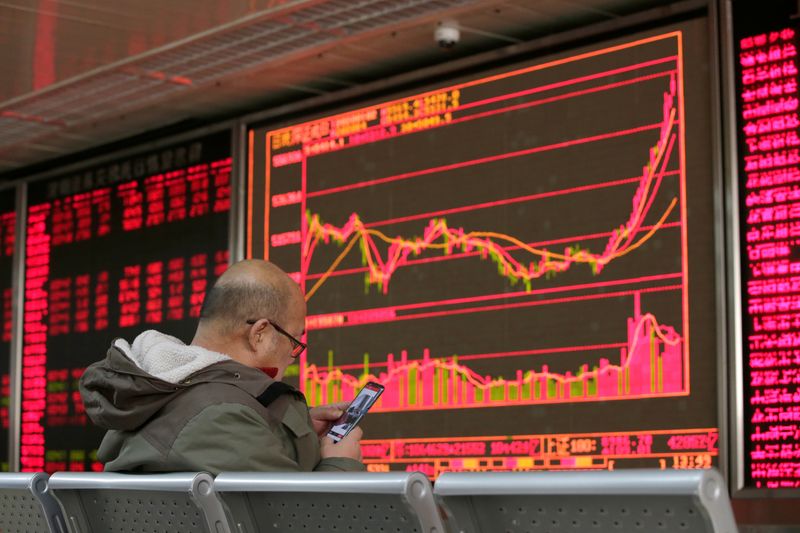By Jiaxing Li and Ankur Banerjee
HONG KONG/SINGAPORE (Reuters) – New shades of capitalism are emerging in China’s tuckered out stock market as companies, at Beijing’s behest, buy back their shares and pay record dividends to investors lying in wait for a so-far evasive rebound.
Investors say the record spree of share buybacks and dividend payouts mark a cultural shift in the market, turning the spotlight on shareholder returns akin to the ongoing corporate governance makeover in Japan.
The dividend yield on Chinese stocks has risen to around 3%, the highest since 2016, rewarding investors who have bravely stayed invested in a market that has been limp for years and faces more stress after Donald Trump’s return as U.S. president.
“China’s regulators and policymakers are trying to engineer this culture of shareholder return,” said Jason Lui, head of Asia-Pacific equities and derivatives strategy at BNP Paribas (OTC:BNPQY).
“If that can be successfully engineered, it will change the makeup of the capital market, and you’ve seen some early sign of that,” referring to increased shareholder returns.
The buybacks and dividends were introduced as part of proposals by Chinese authorities in September to lift stock prices and boost consumer sentiment.
The benchmark CSI 300 index has struggled in recent years, down more than 27% since 2021 against a 65% rise for the S&P 500. The market value of Chinese stocks has stagnated for a decade at around $11 trillion.
Lingering concerns over the indebted property sector, deflationary pressures, lack of big stimulus and geopolitical tensions have hurt sentiment, causing a foreign investment exodus. The threat of tariffs from Trump is another worry.
Even after Beijing showed willingness to boost the market in September, stock prices have lost momentum. The CSI300 index surged 40% in the two weeks after the first stimulus announcements but disappointment with the degree and pace of implementation has seen gains halve since then.
“The simple way to look at it, you should be paid enough of a dividend … for you to take the pain of the fact that the recovery might not happen in valuations,” said Bhaskar Laxminarayan, chief investment officer for Asia at Julius Baer (SIX:BAER).
“You’re being paid for that patience. If you’re not, then it’s not worth it.”
BIG DATA
Chinese firms distributed dividends totalling a record 2.4 trillion yuan ($329.7 billion) in 2024. Share buybacks too rose to a record high 147.6 billion yuan last year, data from regulators showed.
Wu Qing, head of the China Securities Regulatory Commission, said on Thursday that more than 310 companies are expected to pay out dividends totalling more than 340 billion yuan in December and January.
That is a 9-fold increase in the number of companies and a 7.6-fold rise in dividend amount versus the same period last year.
In a sign of how the market is maturing into one where shareholder return is becoming a differentiator, investors have been steadily pouring into dividend-themed exchange-traded funds (ETFs), with nearly $8 billion of inflow since 2020, compared with just $273 million in the previous five years, LSEG Lipper data showed.
The CSI Dividend Index – comprised of traditional energy, financial and material companies that yield high dividends – is up 20% in the past five years compared with a drop of about 8% for the blue-chip CSI300 index.
The CSI growth index sank 25% in the same period.
CULTURAL SHIFT
Policy measures, including a 300 billion yuan share buyback financing programme and guidelines requiring mainland companies to improve shareholder returns and valuations, have helped sharpen the focus on higher-yielding firms.
“China was never a dividend-yielding asset class as a whole, because it was always seen as a growth-oriented play. But now I think we’re in a nice sweet spot where you have both growth and yield,” said Nicholas Chui, China portfolio manager at Franklin Templeton.
Roughly two-thirds of the stocks in Chui’s portfolio are now yielding at least 2%, which is “not just a deliberate allocation on my part, but really the entire market has gone up in yield,” Chui said. “It’s a change in culture.”
Rising dividends also prevent income-seeking mainland investors from rushing into bonds, as they have done for months. The dividend yield is now well above the 1.7% they can earn on 10-year government bonds.
Shares of battery maker Contemporary Amperex Technology and e-commerce behemoth Tencent rose after the companies announced buybacks or dividend payouts.
Goldman Sachs estimates Chinese companies listed at home and abroad could return a total 3.5 trillion yuan to shareholders in 2025, a jump of over 17%.
“Companies don’t know where to put their cash, so they return it now to shareholders. This is a very big shift in mindset,” said Herald van der Linde (NYSE:LIN), head of equity strategy for Asia-Pacific at HSBC.
“I think 10 years ago, you wouldn’t have expected this.”
($1 = 7.2798 Chinese yuan)



